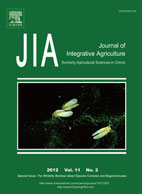|
|
African Cassava Whitefly, Bemisia tabaci, Resistance in African and South American Cassava Genotypes
Christopher AOmongo, Robert Kawuki, Antony C Bellotti, Titus Alicai, Yona Baguma, M N Maruthi, Anton Bua , John Colvin
2012, 11(2):
327-336.
DOI: 10.1016/S1671-2927(00)8550
The whitefly, Bemisia tabaci, is a major pest of cassava, particularly in Africa where it is responsible both for the transmission of plant viruses and, increasingly, for direct damage due to feeding by high populations. To date, there have been no practical solutions to combat this emerging problem, due to the inability of the subsistence farmers that grow cassava to afford expensive inputs such as insecticides. A programme of research was carried out linking institutes in Africa, the UK and South America, to identify possible resistance sources in cassava to the whitefly, Bemisia tabaci. The South American genotype MEcu 72 and several Ugandan cassava landraces including Ofumba Chai, Nabwire 1 and Mercury showed good levels of resistance to B. tabaci. Field and screen-house experiments showed that all of the improved, high-yielding cassava mosaic disease (CMD) resistant cassava genotypes assessed were highly susceptible to B. tabaci and supported high populations of all life stages. These data support the hypothesis that the continuing high populations of cassava B. tabaci in Uganda are due, in part, to the widespread adoption of CMD-resistant cassava varieties during the CMD pandemic. They also show that the whitefly, Aleurotrachelus socialis, resistance present in the South American cassava genotypes could have broader applicability in the Old World.
|
